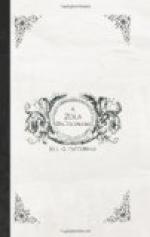GIRAUD (TATA) kept at Plassans a boarding-school for children, where the sculptor Mahoudeau had known Pierre Sandoz and other comrades who met later in Paris. L’Oeuvre.
GODARD (ABBE), cure of Bazoches-le-Doyen. The authorities of Rognes, which was in his parish, refused to provide for a priest of their own, and Abbe Godard, in order to perform Mass, had to walk each Sunday the three kilometres which separated the two communes. He was a short, stout man of hasty temper, who was disgusted with the indifference and irreligion of his parishioners, and his services were the shortest and baldest possible. In spite of his temper, he had, however, a passion for the miserable, and to these he gave everything—his money, his linen, almost the clothes off his back. La Terre.
GODEBOEUF, a seller of herbs who occupied the shop in Rue Pirouette which formerly belonged to Gradelle, the pork-butcher. Le Ventre de Paris.
GODEMARD, a pupil of Dequersonniere, the architect. See Gorju. L’Oeuvre.
GOMARD, the keeper of a working-man’s cafe in Rue de la Femme-sans-Tete, under the sign Au Chien de Montargis. Claude Lantier occasionally took his meals there. L’Oeuvre.
GONIN, a family of fisher-folks who lived at Bonneville. It consisted of Gonin, his wife, and one little girl. A cousin of the wife, named Cuche, came to live with them after his house had been washed away by the sea. Gonin soon after fell into bad health, and his wife and Cuche treated him so badly that the police talked of an inquiry. Pauline Quenu tried to reform the little girl, who had been allowed to grow up wild. La Joie de Vivre.
GORJU, a pupil of Dequersonniere, and himself a future architect. On one of the walls of the studio one could read this brief statement: “The 7th June, Gorju has said that he cared nothing for Rome. Signed, Godemard.” L’Oeuvre.
GOUJET, a blacksmith from the Departement du Nord, who came to Paris and got employment in a manufactory of bolts. “Behind the silent quietude of his life lay buried a great sorrow: his father in a moment of drunken madness had killed a fellow-workman with a crowbar, and after arrest had hanged himself in his cell with a pocket-handkerchief.” Goujet and his mother, who lived with him, always seemed to feel this horror weighing upon them, and did their best to redeem it by strict uprightness. “He was a giant of twenty-three, with rosy cheeks and blue eyes, and the strength of a Hercules. In the workshop he was known as Gueule d’Or, on account of his yellow beard. With his square head, his heavy frame, torpid after the hard work at the anvil, he was like a great animal, dull of intellect and good of heart.” For a time the Coupeaus were his neighbours, and he came to love Gervaise with a perfectly innocent affection, which survived all disillusionments, and subsisted up to the time of her death. It was he who lent her money to start a laundry, and afterwards repeatedly assisted her when in difficulties. L’Assommoir.




